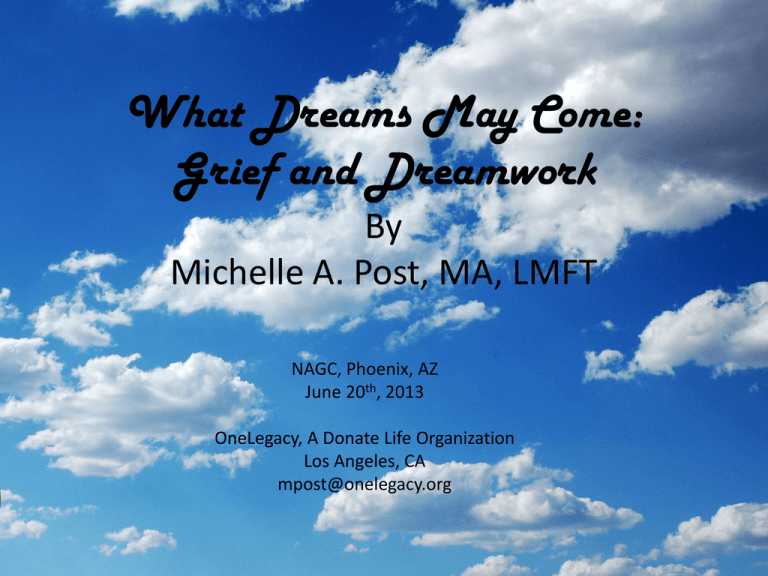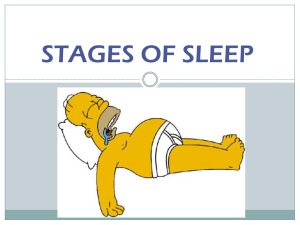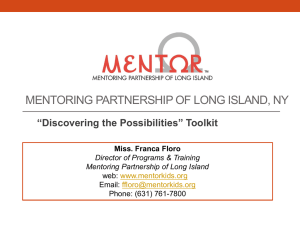Dreams
advertisement

What Dreams May Come: Grief and Dreamwork By Michelle A. Post, MA, LMFT NAGC, Phoenix, AZ June 20th, 2013 OneLegacy, A Donate Life Organization Los Angeles, CA mpost@onelegacy.org OBJECTIVES: Identify the intersection of dreams with the J. William Worden 4 tasks of mourning Describe concerns that caregivers should keep in mind when doing dream work. Apply Gestalt techniques to reveal the meaning of dreams for the mourner. Intro to OneLegacy: • One of 4 Californian Organ Procurement Organizations OPOs (others cover San Diego, Northern Central California, and Northern Western California) • • • • Also eye and tissue donation organization Serve 19 million people Cover 7 Counties Largest OPO & Tissue Recovery Agency in the world Intro to OneLegacy Aftercare • Approximately 2700 new Donors served a year – 2 to 10 family members per donor – up to 27,000 new donor family members per year. Our Philosophy • Adopted Dr. Alan Wolfelt’s idea of “companioning” a bereaved family – We are not the experts on grief; we will take cues from the family to understand what we can do to support them – We will not lead the family in any direction, but be with them through their journey Our Philosophy J. William Worden, Ph.D.’s 4 Tasks of Mourning. • Task I: To Accept the Reality of the (death) • Task II: To Process the Pain of Grief • Task III: To Adjust to a World Without the Deceased • Task IV: To Find an Enduring Connection With the Deceased in the Midst of Embarking on a New Life Worden, J.W. (2009). Grief Counseling & Grief Therapy, Fourth Edition. Springer Publishing Co. LLC, NY, NY. Worden, J.W. (1996). Children & Grief: When a parent dies. Guilford Press, New York, NY. Who Supports the Family? After a family consents to donation, regardless of if we must medically close the case and not transplant… Minimum of 2 years of support from OneLegacy Aftercare Department: giving them follow up letters, grief literature, access to memorial events, grief groups & workshops, phone support, and referrals. More information? • See www.onelegacy.org • Register your wishes www.donatelife.net NOTE: **DNR can interfere w/donation if NOKs don’t know your wishes or if Donation not in end of life documents.) ***Why some donor family members will NOT seek grief support: - judgment, myths and misinformation - peer-support groups & practitioners misinformed. Please educate yourself on the topic of organ & tissue donation. Dreams - Definition Dictionary- Sequence of mental images during sleep that appear involuntarily to the mind of somebody who is sleeping, often a mixture of real and imaginary characters, places, and events Dreams – Research Review Dreams about the dead (Barrett, 1991) • Paracelsus Swiss physician & philosopher: “[If deceased] appear to us in a dream… pay special attention…some people that were sick have been informed [by the dead] what remedies they should use, and after using the remedies, they became cured.” Pg. 97-98 Dreams about the dead (Barrett, 1991) • Part I: 1412 dreams compiled, 149 undergrads (Gender: 58m, 91f; Age: 17-25; Ethnicity: 128Wht, 9Blk, 12H), dream diary 2-6 weeks. 12% dreamed of deceased • Part II: 96 students (Age: 18-42; Gen: 39m, 57f; Eth: 84W, 2B, 10H) asked if ever had a dream about deceased “where you knew even in the dream that they were dead” 39% had these dreams Dreams about the dead (Barrett, 1991) • 4 Categories: – 18% State-of Death: Deceased described “what it is like to be dead”, phone calls, lucid – 23% Advice: Delivered messages to living – 39% Back-to-Life, “I didn’t die” (usually shortly after the death), or desire to change death circumstance – 29% Leave-taking, Chance to say “good-bye”, lucid Dreams about the dead (Barrett, 1991) • Dream Series Trends: 1st: Back-to-life (often disturbing) 2nd: Advice dreams Last: Good-bye dreams Dreams about the dead (Barrett, 1991) Barrett Conclusions: 1) Lucid dreaming can help people settle unfinished emotional business 2) Fertile area to explore death attitudes Spousal Loss and Dreams (Belicki, et. Al. 2003) Sited Kuiken (1993): • Grief is strongest predictor of recurrent dreams among major life stressors • Reminisce about these dreams while awake Spousal Loss and Dreams (Belicki, et. Al. 2003) Conclusions: 1) Deceased being alive earlier in time 2) Dreams support redefining relationship (rather than grief resolution in orderly, timely manner) 3) Dreams = good tool for studying bereavement * Study of one widower’s diary Dead Men Talking – Post Death Contact (Klugman, 2006) Explorations of PDCs via empirical study with phone survey in NV: • 97% of people experience 2+ PDCs • 85% experienced a PDC via dreams of the deceased • 82% via hearing a song = a sign • Type of PDC related to Gender, Marital Status & Education • Connection w deceased does NOT reduce over time Dreams and Death (Cookson, 1990) Literature Review 1) Fear of death 2) Dreams related to bereavement 3) Dreams related to dying Dreams and Death (Cookson, 1990) Literature Review • 90% of widows/widowers dream of spouse • Retrieval/Alive-again dreams most common & occur anytime, usually not painful • Separation dreams – death is acknowledged. Can be painful/scary • Conflict-laden dreams (process guilt/pain and ambivalent relationships) can occur when new relationships happen or purge possessions/change room. Children’s Grief Dreams and Spirituality (Adams & Hyde, 2008) Theory and 2 Case Studies (UK) • Spiritual intelligence = ability to address and solve problems of meaning and value in life. • Siegel and Bulkeley (1998), Bulkeley (2000), Mallon (2002), and Adams (2004, 2005) “all record children’s accounts of dreams… several revealed dreams helped them overcome their loss” pg. 61 • 1st case – pet grief – preparation for death & coping • 2nd case – friend’s death Dream Research? UGH! More is needed on children!!!! Theories Dreams – Sigmund Freud • Attempts to fulfill wishes, arising during sleep, derived from ‘libidinal’ urges • “Day residue” • Real meaning censored Dreams – Carl Jung • Objective – every person in the dream refers to who they are (mom is mom); AND • Subjective: every person is also a part of the dreamer Dreams – Frederick (Fritz) Perls/Gestalt Dreams contain the rejected, disowned parts of the Self, even inanimate • Every character and every object in a dream represents an aspect of the Self. • You are the hurricane, the attacker, the broken down car, the bridge, and the dusty book. • Must role play each object to fill your emotional voids and become whole Dreams – J. William Worden, Ph.D. Gestalt approach with 4 tasks overlaid. 4 Tasks of Mourning: • Task I: To Accept the Reality of the (death) • Task II: To Process the Pain of Grief • Task III: To Adjust to a World Without the Deceased • Task IV: To Find an Enduring Connection With the Deceased in the Midst of Embarking on a New Life Worden, J.W. (2009). Grief Counseling & Grief Therapy, Fourth Edition. Springer Publishing Co. LLC, NY, NY. Worden, J.W. (1996). Children & Grief: When a parent dies. Guilford Press, New York, NY. Dreams & 4 Tasks of Mourning Dreams reflect the task in which the mourner is struggling and we can help the mourner. Examples: 1) Deceased person appears to give permission to have a new relationship. Task? 2) Mourner dreams of deceased person being alive. 3) Deceased person appears and gives advise 4) Dream re-hashes a guilt-producing action Worden Warnings Caregivers should note: 1) Don’t have to include deceased to be relevant. 2) If the deceased appears, note appearance (alive, dead, age, appearance) and process for meaning to dreamer. 3) Don't overlook dream fragments. Useful like puzzle pieces. Worden Warnings Caregivers should note: 4) Let dreamer tell YOU meaning of dream. Don't analyze. Ask dreamer meaning of colors, animals, shapes, items, etc. 5) Look for any underlying themes of any dream series. Worden Warnings Caregivers should note: 6) Anniversary of the death, birthdays, special days, etc. = common time to have dreams. 7) Teach to track (voice recorder/pad next to bed) as soon as awaken. 8) If "I don't dream“, encourage "maybe, just maybe you will start to dream now that we've started therapy/grief support/talking about dreams" OR tell mourner “close eyes and picture person who died, imagine what he/she looks like. What would you say to each other?” Worden Warnings Caregivers should note: 9) Attachments - not all equal. Dreams give clues to attachment issues with the person who died. 10) Nightmares: teach coping and lucid re-occurrences. “Perhaps you will have the dream again with a different ending, one of triumph?” 11) Most children who reported dreams described them as positive and stated they were not afraid of the deceased person appearing to them in a dream. * Harvard Child Bereavement study Michelle’s added suggestion Caregivers should note: 12) Re: Deceased person is not appearing in the mourner’s dreams, mourner wants to. • Normal! Don’t pressure or judge self. • May receive messages of comfort through other symbols. • Are others in family/friends dreaming of deceased w messages? Suggest start a conversation about dreams w others. Lucid Dreaming http://www.wikihow.com/Lucid-Dream Lucid Dreaming #1 During day: • Repeatedly ask "Am I dreaming" • Perform reality checks. *With practice, you’ll automatically remember it during your dreams and do it. Lucid Dreaming #2 Keep a dream journal • Pad or voice recorder • Close to bed • Record immediately *Helps your brain know you want to remember * Recognize dream patters and signs Lucid Dreaming #3 Learn the best time to Lucid dream (sleep schedule?) • Most common - Nap a few hours after waking in morning • REM > right before final waking • Dreams ~ 60 min cycles Interrupted dreams = > memory Lucid Dreaming #4 Stephen Laberge’s mnemonic induction of lucid dreaming (MILD) technique • Set alarm 4.5, 6 or 7.5 hrs after sleep • Try to remember dream • Return to sleep, imagining you are in your previous dream & aware you are dreaming. “I will be aware that I’m dreaming”, sleep. • If random thoughts, repeat imagining & selfsuggestion Lucid Dreaming #5 Attempt WBTB (Wake Back To Bed) Technique. *Most successful • Set alarm 5 hrs after sleep • After wake, stay up for an hour with mind focused on lucidity only • Go back to sleep using the MILD Lucid Dreaming #6 WILD (Wake Initiated Lucid Dream) Technique. Carry awareness from awake directly into REM and start out as a lucid dream. • Easiest = afternoon nap or if only 3-7 hrs of sleep • Meditate into calm, focused stated (counting breaths; imagining climbing up or down stairs; drop through solar system) • Listen to Theta binaural beats for a time until into REM sleep Lucid Dreaming #7 Diamond Method of meditation: • Visualize life awake and dream-life as facets on a diamond. • All life happens at once • Dream Body and Awake Body are the same • Shift awareness into dream state Lucid Dreaming #8 Mark “A” = Awake on your palm. Check palm during the day. Check palm when dreaming. Lucid Dreaming #9 Reality Checks – every time something seems unusual. Must do while awake. DILD – Dream Induced Lucid Dreams • Look at clock to see if it stays constant • Look at text, look away, look back to see if it changed • Flip light switch • Look in a mirror (usually appears blurry, but can appear disfigured or how you see yourself) • Pinch nose closed and try to breathe • Glance at hand and ask, “Am I dreaming?”, often more or less than 5 fingers if dreaming. • Jump in air and able to fly if dreaming. • Poke self. If dream, flesh might be more elastic or can push finger through palm. • Lean again a wall. In dreams, often fall through walls. Lucid Dreaming #10 Prolong a lucid dream by: • Spinning body • Falling backward • Rubbing your hands • If spin or fall, may end up in new space. • If feel a dream shakes or fading, look down to the ground and visualize your surroundings reminding self that you are dreaming Lucid Dreaming #11 Review Dream Journal Patterns? Dream signs? Lucid Dreaming – Modified Hand Tech #12 • Stare at palms for 30 min, repeat “I will dream about…” • Turn light off, sleep • When awake in night, look at hand and repeat and intend to see hand in dream Lucid Dreaming – Other tips • Supplements can help. – An Amino Acid Blend made up of 2000mg L-aspartic acid, 4000mg Lglutamine, and 300mg L-theanine can substantially increase your odds of having a Lucid Dream. – Galantamine used with Choline bitartrate or Alpha-GPC can dramatically increase your odds of becoming Lucid. – 5-HTP is the immediate precursor of serotonin, and can increase your odds of having a Lucid Dream greatly. – Fish Oil helps recall dreams. – Ginko Biloba may have a similar effect to B6. – Vitamin B6 can increase dream vividness. (Bananas, Most fish) – a low dose of caffeine (a caffeinated tea, for instance) shortly before sleeping. • When recalling a dream upon waking, try not to move. Activating your muscle neurons can make it more difficult to access the parts of your brain that allow you to recall your dream. Lucid Dreaming – Modified Hand Tech • If you cannot remember the dream, focus on the feelings that you felt. Trying too hard to remember the dream will only take your mind away from it. Chances are your mind will think of everything but the dream. • Do not drink any fluids for one hour prior to sleeping. The last thing you want is to wake up from successfully lucid dreaming just because you had to use the bathroom. • If you want to dream about something or someone specifically, as you slip into a light sleep, think about that person or that object. The way it feels, the way it looks, the way it smells, etc.. This will cause your mind to focus on that object or person and chances are your dream will reflect upon it. Lucid Dreaming – Modified Hand Tech • If you find the dream is not going how you want it to, "close your eyes" for a bit and then open very forcefully. It might not work the first time but you will eventually end up actually opening them. • Do not use a radio alarm clock. If you hear talking or a song, it will distract you and may clear the dream out of your head. If you have to use a radio alarm clock, don't think about what is playing and quickly turn it off. Alternatively, change the radio setting to a non-assigned frequency so the alarm creates static (white noise). Literature References: • Adams K., & Hyde, B (2008). Children’s grief dreams and the theory of spiritual intelligence. Dreaming, 18, 58-67. • Barrett, D. (1991). Through a glass darkly: images of the dead in dreams. Omega, 24, 97- 108. • Belicki, K., Gulko, N., Ruzycki, K, and Aristotle, J. (2003). Sixteen years of dreams following spousal bereavement. Omega, v. 47 (2), 93-106. • Cookson, K. (1990). Dreams and death: an exploration of the literature. Omega. 21, 259- 281. • Klugman, C. M. (2006). Dead Men Talking: Evidence of Post Death Contact and Continuing Bonds. Omega, v. 53 (3), 249-262. • Worden, J.W. (1996), Children and Grief: When a parent dies. Pages 140-147. Guilford Press, New York, NY. Worden Additional References: • Cooper, C. (1999). Children's dreams during the grief process. Professional school counseling, 3. 137-140. • Garfield, P. 1997 the dream messenger: how dreams of the departed bring healing gifts. Simon & Schuster - ok for clients too. • Kuiken, D., Dunn, S., & LoVerso, T. (2008). Expressive writing about dreams that follow trauma and loss. Dreaming, 18, 77-93. • Moss, E. (2002). Working w dreams in a bereavement therapy group. International journal of group psychotherapy, 52, 151-170. • Volkan, V. (1971). A study of patient's 're-grief work' through dreams, psychological tests and psychoanalysis. Psychiatric Quarterly, 45, 255-273. • Wray, T.J., & Price, A.B. (2005). Grief dreams: How they help heal us after the death of a loved one. San Francisco: Jossey-Bass.









